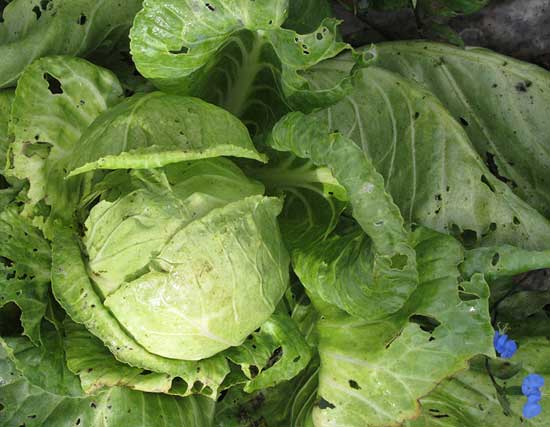Excerpts from Jim Conrad's
Naturalist Newsletter
from the July 2, 2017 Newsletter issued from Rancho Regenesis in the woods ±4kms west of Ek Balam Ruins; elevation ~40m (~130 ft), N20.876°, W88.170°; north-central Yucatán, MÉXICO
CABBAGE
In the garden a nice surprise this year has been that the cabbage turned out OK. Below, you can see a typical cantaloupe-size head:

The cabbage seeds were sown during the cooler dry season, in February, but the plants did most of their growing during April and May, when often afternoon temperatures surpassed 100°F (38°C). During those months the plants were watered nearly every day. To preserve water in the soil, I'd started out by covering the entire cabbage bed with cardboard, and transplanted the young cabbage plants through holes in the cardboard. Who'd have thought that cabbage could do well under such high temperatures?
Only now that most heads are mature are cabbage worms attacking them. If I had BT, the commercially produced spores of Bacillus thuringiensis commonly used in organic gardens up North, I might have less caterpillar problems, though our frequent afternoon rains would reduce its effectiveness by washing it off.
I'm always astonished when I look at a cabbage plant, noting how strange and pretty they are. There are no "wild cabbages" looking like smaller versions of what's shown in our picture. Head cabbage of the kind I'm growing here is one of a remarkable number of human-developed cultivars based on the single wild species known as Brassica oleracea. From Brassica oleracea ancient people domesticated such diverse important garden plants as broccoli, cauliflower, Brussels sprouts, kale, kohlrabi, and various kinds of cabbage. It's thought that cabbage's first cultivars arose somewhere in Europe over 3000 years ago.
One question coming to mind when you look at a head of cabbage is, "How does cabbage reproduce?" In other words, when does it flower, so that seed-producing fruits are formed?
The answer is clear when we know that Brassica oleracea is a biennial plant -- it lives for two years. If the first year's head isn't harvested, in the second year a flowering head emerges from among the previous year's leaves. The whitish-yellow flowers are very typical of the Mustard Family, and from them develop pods with long, conical beaks, the whole capsular-type fruit being about as long as a finger. And when the pods split, cabbage seeds tumble out.